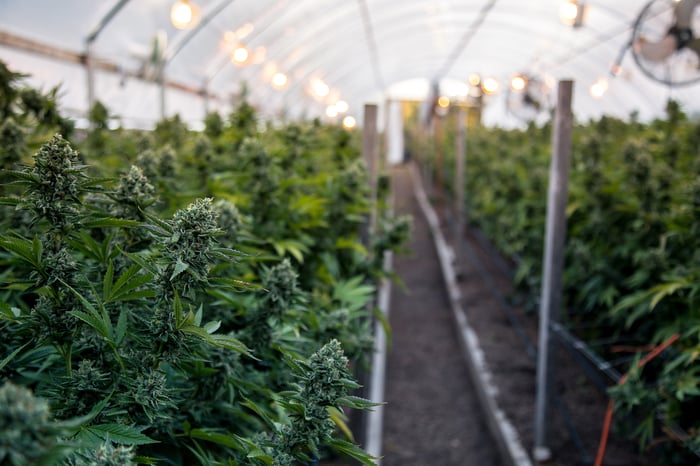For opportunistic investors looking to make money, there's arguably no industry generating more buzz than legal marijuana. Only about once or twice a generation do we really see an industry grow as quickly as legal cannabis may be able to over the next decade. If all goes well, Wall Street foresees between $50 billion and $75 billion in annual worldwide sales by 2029 to 2030.
Since growth like this doesn't come around all the time, marijuana growers have been busy expanding their capacity by any means necessary.

Image source: Getty Images.
Organic growth, acquisitions, and partnerships, oh my!
For some growers it's meant leaning on organic projects. This is what Atlantic-based grower OrganiGram Holdings is doing with its Moncton campus in New Brunswick. When complete, this built-from-the-ground-up facility will have close to 490,000 square feet of growing space and be capable of 113,000 kilos of yearly output.
Meanwhile, other growers have predominantly relied on acquisitions to drive peak production figures higher. Although Aurora Cannabis does have a number of impressive organic projects, including the 1.62-million-square-foot Aurora Sun project in Medicine Hat, Alberta, which will yield at least 230,000 kilos annually when complete, it's been very active on the acquisition front. It gobbled up 140,000 kilos of annual output when it purchased MedReleaf for $2 billion, and may be able to expand annual production at CanniMed, a company it acquired for $850 million, to more than 30,000 kilos.
There's also a middle ground that some growers have leaned on: partnerships. Aphria, which has one massive organic build (Aphria One) that'll provide 110,000 kilos a year when fully operational, is partnered with Double Diamond Farms on the Aphria Diamond project to retrofit existing vegetable-growing greenhouses to produce cannabis. When licensed for cultivation and sales, Aphria Diamond will contribute 140,000 kilos per year.

Image source: Getty Images.
Emerald Health and Village Farms throw their hats into the ring
Most marijuana partnerships are pretty impressive in their own right. But one highly touted partnership simply doesn't leave yours truly all that impressed. That's the joint venture between Emerald Health Therapeutics (EMHT.F) and Village Farms International (VFF 8.13%).
In 2017, Emerald Health and Village Farms agreed to work together to retrofit a 1.1-million-square-foot facility in British Columbia (now known as the Delta 3 greenhouse) that Village Farms had been using to grow vegetables. The agreement made plenty of sense on paper. Emerald Health would be able to save time and money by working with a partner that already had multiple greenhouses, rather than having to construct one from the ground up. Meanwhile, since the vegetable-growing business is traditionally low-margin and weather-dependent, Village Farms would gain entry into a much faster-growing industry by forming a deal with Emerald Health Therapeutics.
Last week, the duo announced that all 1.03 million square feet of allotted cultivation space at Delta 3 was fully planted, putting it on track to achieve full production run rate of 75,000 kilograms by the midpoint of this year.
Furthermore, Emerald Health recently optioned a second vegetable-growing greenhouse from Village Farms adjacent to Delta 3 that will also be retrofitted for cannabis production. Known as the Delta 2 facility, it is 1.1 million square feet. However, since the adjacent Delta 3 facility houses an on-site nursery, the Delta 2 facility will be able to squeeze in a little bit of extra cultivation space. Ultimately, Village Farms and Emerald Health are looking for full operating capacity at Delta 2 by the midpoint of 2020, with an additional 75,000 kilos a year coming from this facility.

Image source: Getty Images.
Sorry, folks, but this partnership isn't all it's cracked up to be
Again, on paper everything looks fine. Pure Sunfarms, as the joint venture is known, should be able to produce 150,000 kilos a year beginning in 2021, which would make it a top-10 grower in Canada by peak output. But there's a big difference between what's on paper and what the final product actually looks like.
My biggest beef with Pure Sunfarms is that I'm struggling to find a cannabis grower that has a worse crop yield. Although the numbers vary a bit, most pot growers are generating right around 100 grams of output per square foot. Anything significantly above this number would be superior to the industry average, whereas anything substantially below would be subpar. Of the roughly 2.1 million square feet devoted to growing space, Emerald Health and Village Farms expect only 150,000 kilos of production. That's just 71 grams per square foot, or almost 30% lower than the industry average. Even with Pure Sunfarms touting low-cost production, it's pretty hard to overlook such unimpressive efficiency figures.
The other problem with Pure Sunfarms is that I don't feel Emerald Health or Village Farms has done nearly enough to secure supply deals for the 75,000 kilos from Delta 3. Sure, Emerald Health has agreed to purchase 25% of the aggregate production from Delta 2 and Delta 3 between 2020 and 2022, but I'm talking about real provincial or overseas deals, not the low-hanging fruit. With the exception of an supply agreement with Ontario announced in the second week of February, neither company has done a particularly good job of securing commitments for their production. That could be troublesome if and when dried flower becomes oversupplied and commoditized in Canada in the years that lie ahead.
While it's always possible that Pure Sunfarms could prove this skeptic wrong, poor efficiency and few provincial supply deals lead me to believe that both Emerald Health and Village Farms International are worth avoiding.





